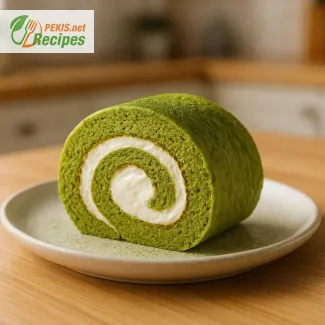
Teriyaki Amberjack, known as Buri no Teriyaki in Japanese, is a dish that masterfully combines simplicity with complexity, creating a flavor profile that is both delicate and deeply satisfying. Amberjack, a prized fish in Japanese cuisine, is celebrated for its firm texture and rich, buttery flavor. When paired with a luscious teriyaki glaze, this dish transforms into a culinary masterpiece that delights the palate and nourishes the soul.
This dish holds a special place in Japanese households and restaurants alike, often enjoyed during festive occasions or as a weeknight indulgence. With its elegant balance of sweet, salty, and umami flavors, Buri no Teriyaki reflects the essence of Japanese cooking—highlighting the natural beauty of fresh ingredients while respecting their integrity.
The Art of Teriyaki
The term teriyaki refers to a traditional Japanese cooking technique where ingredients are grilled or broiled while being basted in a glossy sauce made of soy sauce, mirin, sake, and sugar. The sauce not only adds a brilliant sheen to the dish but also imparts a depth of flavor that elevates the main ingredient—in this case, succulent amberjack fillets. The interplay of caramelized sugars and savory notes creates an irresistible combination that is sure to captivate any food lover.
The Star Ingredient: Amberjack
Amberjack, or buri, is a fish revered in Japanese cuisine for its versatility and exceptional flavor. Its firm, meaty texture holds up beautifully to grilling or pan-searing, while its natural richness pairs harmoniously with the bold teriyaki sauce. This fish is often associated with winter, as the colder months yield amberjack with higher fat content, making it even more flavorful and tender.
Perfecting the Balance
The hallmark of a great Teriyaki Amberjack lies in achieving the perfect balance of flavors. The teriyaki glaze, made from soy sauce, mirin, sake, and sugar, must be carefully reduced to achieve a thick, syrupy consistency that clings to the fish without overpowering its natural taste. When cooked properly, the sauce enhances the amberjack's buttery flavor while adding a delightful caramelized finish.
The cooking process involves pan-searing the fish to create a golden crust, followed by glazing it with the teriyaki sauce. This technique ensures that the fish remains moist and tender on the inside while being coated with a shiny, flavorful exterior.
A Healthy Indulgence
Not only is Buri no Teriyaki a feast for the senses, but it also offers numerous health benefits. Amberjack is a rich source of omega-3 fatty acids, which are known to support heart health, reduce inflammation, and promote brain function. The teriyaki sauce, when made with high-quality ingredients, adds a touch of sweetness without being overly indulgent.
This dish is an excellent choice for those seeking a nutritious yet satisfying meal. Pair it with a bowl of steamed rice and a side of lightly pickled vegetables for a well-rounded and wholesome dining experience.
A Dish for All Occasions
Whether you're preparing a meal for a special gathering or looking to elevate your everyday dinner repertoire, Teriyaki Amberjack is a recipe that never fails to impress. Its stunning presentation, with the fish glistening under the rich glaze, is as appealing to the eyes as it is to the taste buds.
The dish's versatility also makes it a perfect canvas for creativity. Add a sprinkle of sesame seeds for a nutty crunch, or garnish with finely sliced spring onions to enhance the dish's freshness. For those who enjoy a hint of spice, a dash of chili flakes can provide an exciting contrast to the sweet and savory flavors.
A Timeless Classic
In the world of Japanese cuisine, Buri no Teriyaki is a timeless classic that continues to win hearts across the globe. Its exquisite balance of flavors, simple preparation, and elegant presentation make it a dish that transcends cultural boundaries and culinary traditions.
Whether you're a seasoned chef or a home cook exploring the world of Japanese flavors, Teriyaki Amberjack invites you to experience the artistry and passion behind one of Japan's most beloved dishes. With every bite, you'll savor the harmonious interplay of ingredients that define the essence of Japanese cooking—fresh, flavorful, and unforgettable.
- Prepare the teriyaki sauce: In a small bowl, mix soy sauce (60 ml / 4 tbsp), sake (30 ml / 2 tbsp), mirin (30 ml / 2 tbsp), and sugar (20 g / 2 tbsp). Stir until the sugar is dissolved.
- Prepare the amberjack fillets: Pat the fillets dry with a paper towel. Ensure they are free of moisture to achieve a proper sear.
- Heat the pan: In a large non-stick skillet, heat vegetable oil (15 ml / 1 tbsp) over medium heat.
- Sear the fillets: Place the amberjack fillets in the skillet and cook for 3–4 minutes on each side, or until golden brown and cooked through. Remove the fillets from the skillet and set aside.
- Cook the teriyaki sauce: Pour the prepared sauce into the skillet and bring it to a simmer. Reduce the heat to low and let it thicken slightly, about 2–3 minutes.
- Glaze the fish: Return the amberjack fillets to the skillet and coat them with the teriyaki sauce. Let them cook in the sauce for 1–2 minutes, ensuring they are evenly glazed.
- Serve: Transfer the glazed fillets to a serving dish. Drizzle any remaining sauce over the fish and garnish with optional toppings like sesame seeds or finely sliced spring onions.
Enhancing and Customizing Teriyaki Amberjack (Buri no Teriyaki)
Teriyaki Amberjack (Buri no Teriyaki) is a beloved Japanese dish celebrated for its rich, savory-sweet glaze and buttery fish fillets. While the recipe itself is straightforward and relies on a few high-quality ingredients, there is plenty of room for experimentation and personalization. Whether you're catering to dietary preferences, looking to add unique flavors, or simply elevating the dish, small changes can have a significant impact. Below, we delve into detailed tips and ingredient substitutions that will transform this classic dish into a customizable masterpiece.
Substituting the Fish
The star of the dish, amberjack, is known for its firm, meaty texture and rich flavor. However, if amberjack is unavailable or if you'd like to try something different, consider these alternatives:
- Salmon: With its natural fattiness, salmon works wonderfully in this dish. It absorbs the teriyaki glaze beautifully and provides a slightly richer taste. Opt for fillets with the skin on for added texture.
- Sea bass: This mild-flavored fish pairs excellently with the sweet and savory teriyaki sauce. Its delicate texture provides a lighter alternative to amberjack.
- Mahi-mahi or cod: For a more subtle flavor, mahi-mahi or cod are excellent choices. These fish are leaner, so be cautious not to overcook them, as they can dry out easily.
How this impacts the dish: Changing the fish can subtly alter the flavor profile, with fattier fish enhancing the richness of the sauce and leaner fish creating a lighter dish. Choose fish based on your desired balance between richness and delicacy.
Adjusting the Teriyaki Sauce
The teriyaki sauce is the heart of this recipe, offering the perfect combination of salty, sweet, and umami. Modifying the sauce ingredients can give the dish a unique twist:
- Adding honey or maple syrup: Replace part of the sugar with honey or maple syrup for a deeper, more complex sweetness. This addition also gives the sauce a slight floral or earthy note.
- Using brown sugar: Substituting white sugar with brown sugar adds a subtle molasses flavor and enhances the caramelization of the sauce.
- Incorporating garlic and ginger: While not traditional, adding minced garlic and grated ginger to the sauce provides extra depth and a hint of spice. This addition works especially well for those who enjoy bolder flavors.
- Including citrus juice: A splash of orange or yuzu juice in the sauce adds brightness and balances the sweetness with a tangy kick.
How this impacts the dish: Modifying the sauce allows you to customize the flavor balance. Sweeter sauces pair well with lighter fish, while spiced or tangy sauces can cut through the richness of fattier fish.
Altering Cooking Techniques
The traditional method of cooking Teriyaki Amberjack involves pan-searing the fish and glazing it with the sauce. However, you can explore other techniques to enhance the dish:
- Grilling: For a smoky, charred flavor, grill the amberjack instead of pan-searing it. Brush the fish with the sauce as it cooks to create a beautifully caramelized exterior.
- Baking: If you prefer a hands-off approach, bake the fish in the oven at 200°C (400°F) for about 12–15 minutes, glazing it with the teriyaki sauce during the last few minutes of cooking.
- Sous vide: To achieve a perfectly tender texture, cook the fish sous vide at 52°C (125°F) for 30 minutes, then finish it by searing in a hot pan with the sauce.
How this impacts the dish: Each cooking method brings unique textures and flavors. Grilling adds a smoky element, baking creates a cleaner finish, and sous vide guarantees moist, evenly cooked fish.
Accompaniments and Pairings
The traditional pairing for Buri no Teriyaki includes steamed white rice and pickled vegetables. You can customize these side dishes to suit your preferences or elevate the meal:
- Swap white rice for brown rice or quinoa: These alternatives add a nutty flavor and a boost of fiber.
- Add roasted vegetables: Instead of pickled vegetables, serve the fish with roasted asparagus, carrots, or bok choy for a heartier side dish.
- Incorporate noodles: Serve the amberjack over soba noodles tossed in a light sesame dressing for a more substantial meal.
How this impacts the dish: Changing the sides can transform the overall dining experience. Heartier accompaniments make the dish more filling, while lighter sides keep it refreshing and balanced.
Making It Vegetarian or Vegan
If you want to create a plant-based version of this dish, you can replace the fish with:
- Firm tofu: Cut tofu into thick slices and pan-sear it before glazing with teriyaki sauce.
- Eggplant or mushrooms: Grill thick slices of eggplant or portobello mushrooms and baste them with the sauce for a smoky, umami-packed alternative.
How this impacts the dish: A vegetarian or vegan version retains the bold teriyaki flavors while providing a completely different texture and appearance.
Balancing the Nutritional Profile
This recipe is already a healthy choice, but minor adjustments can further optimize its nutritional benefits:
- Reduce the sugar: Cut back on sugar in the sauce to make it more suitable for those watching their sugar intake.
- Increase omega-3s: Use salmon or mackerel instead of amberjack to boost omega-3 fatty acid content.
- Lower sodium: Opt for low-sodium soy sauce to reduce the dish's overall sodium levels.
How this impacts the dish: These adjustments make the recipe more suitable for specific dietary needs without compromising flavor.
The beauty of Teriyaki Amberjack lies in its simplicity and versatility. By experimenting with different ingredients, cooking techniques, and accompaniments, you can tailor this dish to suit your personal preferences or dietary requirements. Whether you're seeking to enhance the flavors, make it healthier, or try a plant-based version, small changes can lead to big rewards, creating a dish that's uniquely yours while staying true to its Japanese roots.
- Soy (in the soy sauce).
- Fish (amberjack).
- Gluten (if using regular soy sauce).
Substitution Tips to Address Allergens and Gluten:
- Replace soy sauce with gluten-free tamari to make the dish gluten-free.
- For a soy-free option, use coconut aminos instead of soy sauce.
- Vitamin D: 4 µg (essential for bone health and immune function).
- Vitamin B12: 3 µg (supports nervous system health and red blood cell production).
- Omega-3 fatty acids: 1.5 g (promotes heart health and reduces inflammation).
- Selenium: 35 µg (protects cells from oxidative damage and supports thyroid function).
- Phosphorus: 250 mg (important for energy metabolism and bone strength).
- Selenium: 35 µg (neutralizes free radicals and protects cells from oxidative stress).
- Polyphenols in mirin and sake: Trace amounts (support cardiovascular health and reduce inflammation).
- Caramelized sugars: Enhance the antioxidant potential of the dish by forming Maillard reaction compounds.
Teriyaki Amberjack is a nutritious, flavorful dish that combines traditional Japanese flavors with a rich array of health benefits. It’s perfect for any occasion and simple to adapt for dietary needs.





